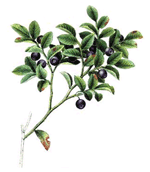
Bilberry
Introduction
This fact sheet provides basic information about bilberry-common names, uses, potential side effects, and resources for more information. Bilberry is a relative of the blueberry, and its fruit is commonly used to make pies and jams. It has been used for nearly 1,000 years in traditional European medicine. Bilberry grows in North America, Europe, and northern Asia.Common Names
bilberry, European blueberry, whortleberry, huckleberryLatin Names
Vaccinium myrtillusWhat It Is Used For
- Historically, bilberry fruit was used to treat diarrhea, scurvy, and other conditions.
- Today, the fruit is used to treat diarrhea, menstrual cramps, eye problems, varicose veins, venous insufficiency (a condition in which the veins do not efficiently return blood from the legs to the heart), and other circulatory problems.
- Bilberry leaf is used for entirely different conditions, including diabetes.
How It Is Used
The fruit of the bilberry plant can be eaten or made into extracts. Similarly, the leaves of the bilberry plant can be made into extracts or used to make teas.What the Science Says
- Some claim that bilberry fruit improves night vision, but clinical studies have not shown this to be true.
- There is not enough scientific evidence to support the use of bilberry fruit or leaf for any health conditions.
Side Effects and Cautions
- Bilberry fruit is considered safe. However, high doses of bilberry leaf or leaf extract are considered unsafe due to possible toxic side effects.
- Tell your health care providers about any complementary and alternative practices you use. Give them a full picture of what you do to manage your health. This will help ensure coordinated and safe care.
Sources
- Bilberry. Natural Medicines Comprehensive Database Web site. Accessed July 2, 2007.
- Bilberry (Vaccinium myrtillus). Natural Standard Database Web site. Accessed June 28, 2007.
- Bilberry fruit. In: Blumenthal M, Goldberg A, Brinckman J, eds. Herbal Medicine: Expanded Commission E Monographs. Newton, MA: Lippincott Williams & Wilkins; 2000:16-21.
- NCCAM National Institutes of Health






